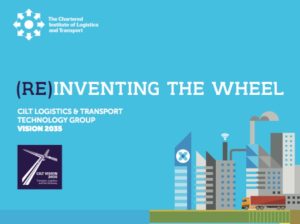CILT report in focus: The big changes for transport over the next 25 years
A new report by the Chartered Institute of Logistics and Transport examines a range of issues relating to transport over the next 25 years and looks at potential new technologies. We review the findings.

The CILT report reviews the potential of technology in transport that might be available by 2035 to advise on policy and priorities for R&D.
Dubbed (Re)Inventing the wheel, the latest Chartered Institute of Logistics and Transport (CILT) report builds on its initial Vision 2035 guide from September 2011 and provides an up-to-date look at the potential of technology in transport that might be available by 2035.
Main findings from the latest 32-page report include:
Dramatic increases in communications could improve journeys
Passenger and traffic information systems are already widespread but future evolutions are expected to automatically suggest any alternatives available if connections are missed, or journeys are delayed by congestion.
But such developments will widen the gap between urban and rural areas – as well as generations.
The report adds that routing and scheduling systems will be integrated across all platforms, which will allow commercial fleets to collaborate to reduce the impact on road capacities, particularly at peak times
MaaS has the potential to enable easier journeys
One of the opportunities created by improved communications is in shared mobility and the introduction of Mobility as a Service (MaaS) is a “golden opportunity to use pricing to offer greater choices to the user and to maximise the efficient use of infrastructure”, according to the report.
Yet the report warns that the speed of take-off of MaaS will be strongly influenced by the abilities of large, interested utility and service provider market entrants to process and analyse data to provide an attractive MaaS service package to consumers.
It adds that research will need to be carried out on the barriers to adoption of MaaS.
Developments in payment systems to open up travel
Improvements in technology are enabling a whole range of ticketless options to be developed. Payment for road use and parking is also being made easier, with various electronic passes or automatic number plate recognition technology for tolls, congestion charge zones and car parks. Refinements are likely, including freight-industry-wide telemetry systems, which will enable this technology to arrange payments for time and location related road-user charging.
By 2035 such technology is likely to be fully developed and in widespread use.
Work needed behind scenes for electric vehicle take-up
As technology improves, take-up of electric vehicles will gather pace such that, by 2035, no new cars should be produced that rely on fossil fuel alone.
However, the report says pressure must continue to be exerted given the undoubted additional costs of lower carbon generation methods for electricity. Carbon capture and storage technologies will almost certainly be necessary for the share of electricity that remains to be generated from fossil fuels.
Distribution of electricity is also a key factor in take-up – workplace and public car parks are suitable locations for charging, but the payment system must operate equitably.
Autonomous control could bring mixed benefits
Autonomous vehicles look set to improve safety, efficiency and capacity on our roads but work is needed to overcome the interim issue of having both autonomous and semi-autonomous vehicles in use at the same time.
Other issues need to be considered by the Government – for example, if autonomous vehicles open up usage to more groups of people, will roads actually end up more crowded?
Social media to bring valuable source of info
Social media use will provide a valuable source of knowledge about travellers’ perceptions for transport providers and researchers. In particular, social media could be developed for transport in research and development.
Open data to bring issues
Open data brings a wide number of benefits to transport these days, including enabling drivers using apps such as Google Maps to warn other users of congestion.
Yet traffic management, parking and loading rules need to be acknowledged – especially for autonomous vehicles – and pricing and charging regimes need to be included, in particular if road pricing becomes widespread, to ensure that systems maximise the efficiency of use of the infrastructure.
To access the full report, click here.












